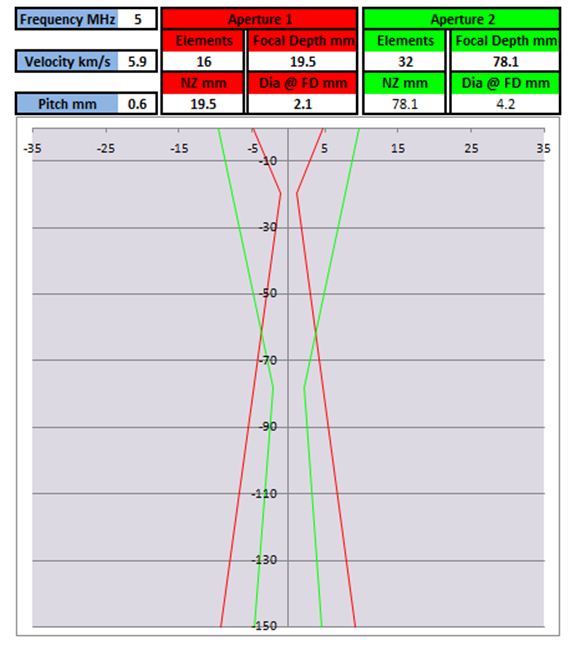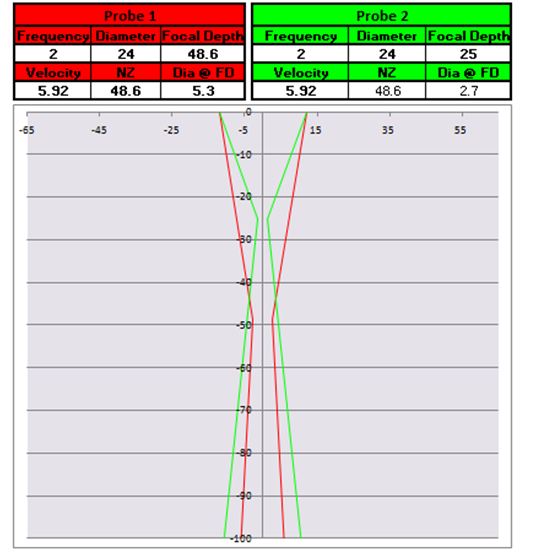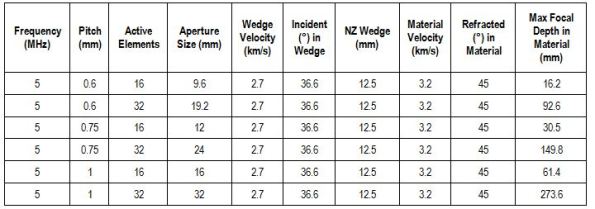Archive
Time of Flight Diffraction (TOFD) Training Tool
New Training Tools
A Time of Flight (TOFD) calculator/simulator has been added to the library of training tools.
Click HERE to download TOFD calculator.
Click HERE to view all of ATTAR training tools.
Focusing with Phased Array
One of the numerous advantages of Phased Array (PA) over conventional Ultrasonics (UT) is the ability to focus the beam to increase sensitivity and resolution over a range of thicknesses.
Natural Beam Profile (Un-focused)
The shape of the unfocused beam is controlled by those factors that control the Near Zone. In Phased Array these are:
- Wavelength, determined by velocity and frequency
- Probe Element Pitch, distance between centre of elements
- Aperture Active Elements, number of elements electronically fired to form a single array
Figure 1: Showing effect of aperture size on Near Zone and beam profile
Conventional Focusing (Mechanical)
- Has the capability to converge the acoustic energy into a small focal spot
- In an un-focused conventional probe, the focal point is the end of the Near Zone
- Focusing cannot occur beyond the Near Zone. NZ=d2/4λ
- The increase in sensitivity is a function of the reduction of the beam width when the beam is focused.
- Focusing decreases the depth of field (DOF), the distance between the nearest and farthest reflectors in a beam that provide acceptable sensitivity for detection
- Focusing generally done mechanically, at a fixed distance
Figure 2:
.
Depth Comparison:
- Probe 1 is unfocused at 48.6mm (NZ depth). Probe 2 is focused at 25mm depth
- 25mm : Probe 2 increased sensitivity as compared to Probe 1.
- 75mm: Probe 2 lower sensitivity as compared to Probe 1 (reduction in DOF)
Phased Array Focusing (Electronic)
- Has the capability to converge the acoustic energy into a small focal spot
- Allows for focusing at several depths, using a single probe
- Can only perform in the steering plane, when using a 1D-array
- Focusing decreases the depth of field (DOF), the distance between the nearest and farthest reflectors in a beam that provide acceptable sensitivity for detection
- Focusing cannot occur beyond the Near Zone. NZ=A2/4λ (A= Active Aperture)
- Active Aperture = element pitch x number active elements
- Focusing performed electronically.
Figure 3:
Depth Comparison:
- Aperture 1 is unfocused at 78.1mm (NZ depth). Aperture 2 is focused at 30mm depth.
- 30mm : Aperture 2 increased sensitivity as compared to Probe 1
- 130mm: Aperture 2 lower sensitivity as compared to Aperture 1 (reduction in DOF)
Maximum depth of focusing with Phased Array
The following tables show the maximum depth of focusing for a range of typical PA setups.
Table 1: Zero Degree , Contact – No Wedge
|
Frequency (MHz) |
Pitch (mm) |
Active Elements |
Aperture Size (mm) |
Velocity (km/s) |
Max Focal Depth (mm) |
|
5 |
0.6 |
16 |
9.6 |
5.9 |
19.5 |
|
5 |
0.6 |
32 |
19.2 |
5.9 |
78.1 |
|
5 |
0.75 |
16 |
12 |
5.9 |
30.5 |
|
5 |
0.75 |
32 |
24 |
5.9 |
122.0 |
|
5 |
1 |
16 |
16 |
5.9 |
54.2 |
|
5 |
1 |
32 |
32 |
5.9 |
216.9 |
Table 2: Zero Degree , Perspex Wedge 20mm Thick
|
Frequency (MHz) |
Pitch (mm) |
Active Elements |
Aperture Size (mm) |
Wedge Velocity (km/s) |
Near Zone In Wedge (mm) |
Material Velocity (km/s) |
Max Focal Depth in Material (mm) |
|
5 |
0.6 |
16 |
9.6 |
2.7 |
20.0 |
5.9 |
10.4 |
|
5 |
0.6 |
32 |
19.2 |
2.7 |
20.0 |
5.9 |
68.9 |
|
5 |
0.75 |
16 |
12 |
2.7 |
20.0 |
5.9 |
21.4 |
|
5 |
0.75 |
32 |
24 |
2.7 |
20.0 |
5.9 |
112.9 |
|
5 |
1 |
16 |
16 |
2.7 |
20.0 |
5.9 |
45.1 |
|
5 |
1 |
32 |
32 |
2.7 |
20.0 |
5.9 |
207.8 |
Table 3: Angle Scan – 45 Degrees, Assumed Element Height in Wedge 10mm
Table 4: Angle Scan – 70 Degrees, Assumed Element Height in Wedge 10mm
From the above tables the following observations are clear:
- Probe Pitch and Number of Active Elements have major affect on the maximum depth of focusing.
- Wedge size and starting element will have a pronounced affect on maximum depth of focusing.
- Inspections at increasing angles will have a pronounced affect on maximum depth of focusing.
As the large majority of Phased Array units sold to date (over 80%), have a Maximum Active Aperture of 16 elements, the restriction is generally in the phasing unit rather that probe parameters.
Conclusion:
Focusing with phased array provides significant improvements in inspection sensitivity and resolution at the cost of depth of field. Note: Options such as Dynamic Depth Focusing (DDF) can be used to increase depth of field.
Maximum Depth of focusing is much less that most inspectors expect and is limited by probe selection and phasing hardware.
An understanding of the physics behind the focusing allows inspectors to use suitable configurations to maximise the inspection capability.
Dragline Boom Cluster Cracking
Photos of BE1370 Boom Cluster
Cracking initially detected with Ultrasonics.
Lacing removed and MPI to confirm.
Repaired
Ultrasonics and MPI post repair.
Image showing cracks confirmed with MPI
Image post repair







